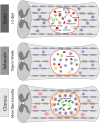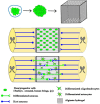Biomaterials targeting the microenvironment for spinal cord injury repair: progression and perspectives
- PMID: 38784712
- PMCID: PMC11111957
- DOI: 10.3389/fncel.2024.1362494
Biomaterials targeting the microenvironment for spinal cord injury repair: progression and perspectives
Abstract
Spinal cord injury (SCI) disrupts nerve pathways and affects sensory, motor, and autonomic function. There is currently no effective treatment for SCI. SCI occurs within three temporal periods: acute, subacute, and chronic. In each period there are different alterations in the cells, inflammatory factors, and signaling pathways within the spinal cord. Many biomaterials have been investigated in the treatment of SCI, including hydrogels and fiber scaffolds, and some progress has been made in the treatment of SCI using multiple materials. However, there are limitations when using individual biomaterials in SCI treatment, and these limitations can be significantly improved by combining treatments with stem cells. In order to better understand SCI and to investigate new strategies for its treatment, several combination therapies that include materials combined with cells, drugs, cytokines, etc. are summarized in the current review.
Keywords: biomaterial scaffolds; cell transplantation; spinal cord injury; spinal cord repair; stem cell.
Copyright © 2024 Gao, Wang, Wu and Liu.
Conflict of interest statement
The authors declare that the research was conducted in the absence of any commercial or financial relationships that could be construed as a potential conflict of interest.
Figures


Similar articles
-
Exosomes combined with biomaterials in the treatment of spinal cord injury.Front Bioeng Biotechnol. 2023 Mar 13;11:1077825. doi: 10.3389/fbioe.2023.1077825. eCollection 2023. Front Bioeng Biotechnol. 2023. PMID: 36994357 Free PMC article. Review.
-
Recent Advances in Cell and Functional Biomaterial Treatment for Spinal Cord Injury.Biomed Res Int. 2022 Aug 8;2022:5079153. doi: 10.1155/2022/5079153. eCollection 2022. Biomed Res Int. 2022. Retraction in: Biomed Res Int. 2024 Jan 9;2024:9760680. doi: 10.1155/2024/9760680. PMID: 35978649 Free PMC article. Retracted. Review.
-
Biomaterial-supported MSC transplantation enhances cell-cell communication for spinal cord injury.Stem Cell Res Ther. 2021 Jan 7;12(1):36. doi: 10.1186/s13287-020-02090-y. Stem Cell Res Ther. 2021. PMID: 33413653 Free PMC article. Review.
-
Restoration of spinal cord injury: From endogenous repairing process to cellular therapy.Front Cell Neurosci. 2022 Nov 29;16:1077441. doi: 10.3389/fncel.2022.1077441. eCollection 2022. Front Cell Neurosci. 2022. PMID: 36523818 Free PMC article. Review.
-
The Application of Biomaterials in Spinal Cord Injury.Int J Mol Sci. 2023 Jan 3;24(1):816. doi: 10.3390/ijms24010816. Int J Mol Sci. 2023. PMID: 36614259 Free PMC article. Review.
Cited by
-
Innovative Strategies in 3D Bioprinting for Spinal Cord Injury Repair.Int J Mol Sci. 2024 Sep 4;25(17):9592. doi: 10.3390/ijms25179592. Int J Mol Sci. 2024. PMID: 39273538 Free PMC article. Review.
-
Enhancing Functional Recovery After Spinal Cord Injury Through Neuroplasticity: A Comprehensive Review.Int J Mol Sci. 2025 Jul 9;26(14):6596. doi: 10.3390/ijms26146596. Int J Mol Sci. 2025. PMID: 40724846 Free PMC article. Review.
-
Multidimensional exploration of hydrogels as biological scaffolds for spinal cord regeneration: mechanisms and future perspectives.Front Bioeng Biotechnol. 2025 Apr 23;13:1576524. doi: 10.3389/fbioe.2025.1576524. eCollection 2025. Front Bioeng Biotechnol. 2025. PMID: 40336551 Free PMC article. Review.
-
Engineered Healing: Synergistic Use of Schwann Cells and Biomaterials for Spinal Cord Regeneration.Int J Mol Sci. 2025 Aug 16;26(16):7922. doi: 10.3390/ijms26167922. Int J Mol Sci. 2025. PMID: 40869240 Free PMC article. Review.
References
-
- Bacakova L., Zarubova J., Travnickova M., Musilkova J., Pajorova J., Slepicka P., et al. . (2018). Stem cells: their source, potency and use in regenerative therapies with focus on adipose-derived stem cells – a review. Biotechnol. Adv. 36, 1111–1126. doi: 10.1016/j.biotechadv.2018.03.011, PMID: - DOI - PubMed
Publication types
LinkOut - more resources
Full Text Sources

